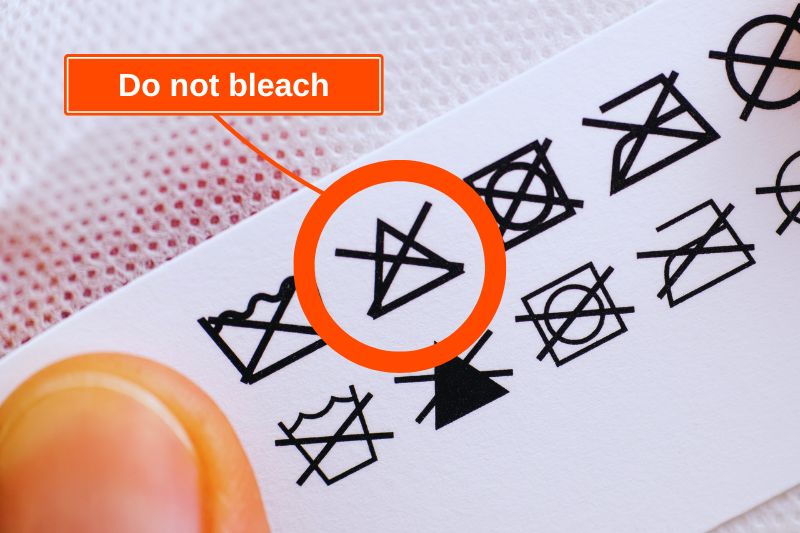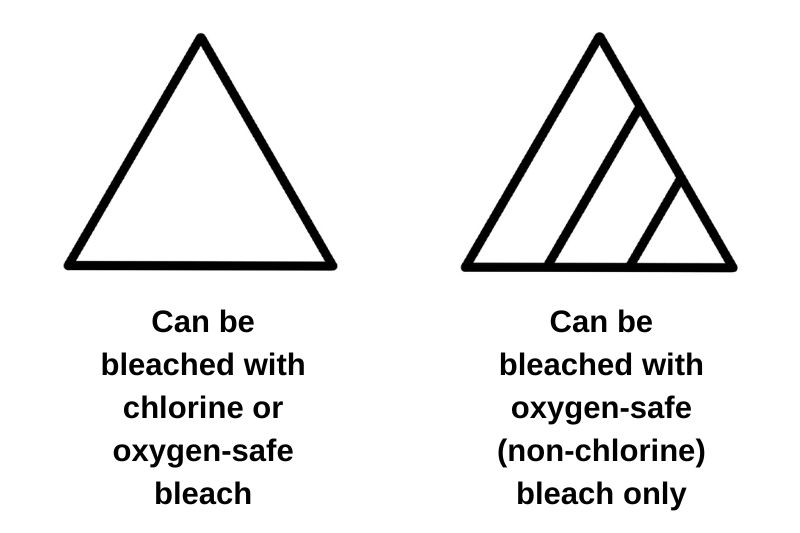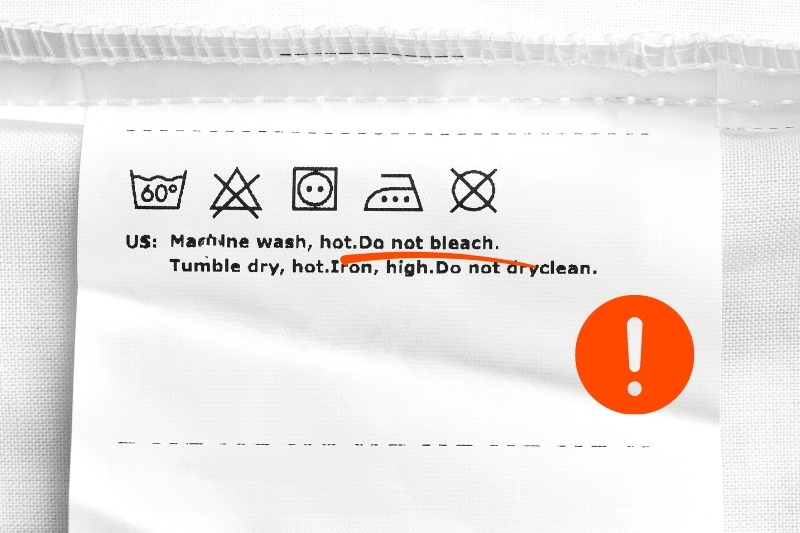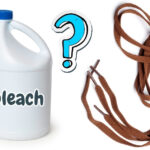Just dropped a load of bolognese sauce over your new dress? Before you grab the bleach and douse your frock in it, check the care label to see if it can be cleaned with bleach.
Not all items are bleach-friendly. Don’t take the risk and ruin your outfit. Check the tag for a “Do Not Bleach” symbol!
What Is the “Do Not Bleach” Symbol?

The “Do Not Bleach” symbol is a triangle with a cross going through it. The words “Do Not Bleach” may also be written on the care tag.
You shouldn’t use any form of bleach (chlorine or oxygen bleach) to treat an item that has “Do Not Bleach” written on its care label.
If you see a crossed-out triangle symbol on the care label, step away from the bleach and find an alternative cleaning method.
If you bleach your item, you will likely damage it, and you may not be able to unbleach and repair it!
What Is the Symbol for ‘Bleach Safe’?
If an item of clothing can be bleached, it will have one of the following symbols on its care tag:
A blank triangle
The outline of a triangle means that your item can be bleached with chlorine or oxygen-safe bleach. However, you must dilute the bleach in water before you use it.
A triangle with two diagonal lines
If you see a triangle with two diagonal lines in its centre, this means that the garment can be bleached with oxygen-safe bleach only.
You shouldn’t use chlorine bleach on the item because it will cause irreparable damage and discolouration.
Again, the oxygen-safe bleach must be diluted in water before you use it.
A crossed-out triangle with the letters ‘CL’
A triangle with the letters ‘CL’ etched into its middle and a cross going through it means that you can use an oxygen-safe bleach to clean your item of clothing if it’s essential.
You should not use chlorine bleach on the garment because the bleach will likely damage and discolour the piece.

Can You Bleach Something That Says “Do Not Bleach”
If you see a triangle symbol with a cross going through it on a care label, you should not bleach the item. You shouldn’t use either chlorine or oxygen-safe bleach on the garment.
If you were to clean your outfit with bleach, the material would likely weaken, become discoloured and perhaps break entirely. In the end, you’d have a severely damaged and stained garment.
When an item’s tag states that it shouldn’t be bleached, you should find another way to treat it.
There are several other ways you can remove stains from clothes. For example, you could use bicarbonate of soda, white vinegar, or an off-the-shelf stain remover.
Just determine the blemish and pick a suitable solution to remove the mark off the item.
If you go against the advice on the tag and bleach your garment regardless, you do so at your own risk.
You should expect your item to sustain some sort of damage during the bleaching process. You may be lucky, especially if you use oxygen bleach, but there’s no guarantee!
Why Do Some White Clothes Say “Do Not Bleach”?

It may seem counterintuitive to see a “Do Not Bleach” symbol on a white item of clothing because bleach is known for its whitening and disinfecting properties. So, you’d naturally assume that it would be okay to bleach said items. This isn’t strictly the case, though.
Bleach cannot be used on all types of material, even if it’s white in colour, because it can weaken and damage the fibres of the clothes. Let’s look at this in more detail:
Bleach will damage the material in question
Many white garments are made from fabrics that can be damaged by bleach. For example, silk and wool will degrade when exposed to a harsh chemical like bleach. The damage in question is often irreversible on delicate materials, too.
A “Do Not Bleach” symbol is popped onto the delicate white garment to prevent damage.
Repeatedly bleaching, even hard-wearing white clothes, will eventually lead to a thinning of the material. You’ll hear people talking about clothes looking ‘threadbare’. Excess bleaching can make garments lose shape, texture, and comfortable feel.
To protect the structure and lifespan of a white garment, manufacturers put a “Do Not Bleach” symbol on the care label so people are warned against bleaching it.
In short, you’re advised not to bleach your item so it sticks around for longer.
As a rule, you will be given lots of other washing instructions to help preserve the material. Instructions like how to wash the outfit, what water temperature to use, and if you can iron it. Stick to these instructions to ensure your garment is cared for effectively.
Blended materials
Lots of white clothes are made from a blend of materials. For example, you could have a white cotton top with a lacey trim. In this case, the cotton might be able to stand up to the bleach, but the lace won’t.
Consequently, the trim will end up damaged after being exposed to bleach, and the top may become unwearable.
Similarly, if you have a white dress that’s covered in colourful, delicate embroidery and you bleach it, you’ll discolour it.
A “Do Not Bleach” symbol on your white item of clothing stops you from ruining your blended clothes.
Environmental awareness
Bleach is a harsh chemical that is dangerous to humans, animals and the environment. So, to be a bit more considerate, manufacturers advise people not to bleach their garments, white clothes included. It’s a small step in the right direction of helping the environment.
Treated clothes
Some clothes are treated with alternatives to whiteners and brighteners, which means that when you bleach these white garments, they don’t ‘bleach’ as you’d hope. Instead, nothing happens, or the items go a yellow/brown colour.
This yellowing effect obviously tarnishes the white item and is difficult to put right. Hence, the manufacturer slaps a “Do Not Bleach” symbol on the garment.
Health concerns
Bleach can cause skin irritation and allergy flare-ups, which is why some white garments have a “Do Not Bleach” symbol. Essentially, the manufacturer is advising you not to bleach the garment so you stay safe.

Bethan has a passion for exploring, reading, cooking and gardening! When she’s not creating culinary delights for her family, she’s concocting potions to keep her house clean!






